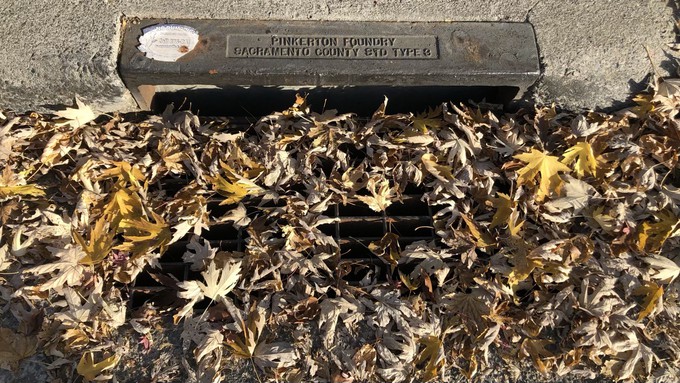
2022 could be driest year in Sacramento history

Here's a clogged drain and flooded gutter waiting to happen, with rain expected to begin in the early-morning hours Thursday. Kathy Morrison
Be prepared to get wet – and it’s about time. Sacramento is long overdue for a good, deep soaking.
According to the National Weather Service, Sacramento can expect 1.15 inches on Thursday, the first day of December. After a frosty Friday (with early-morning lows expected to hit 32 degrees), another inch of rain is predicted for this weekend.
That will get December’s rain totals off to a solid start. Historically, December in Sacramento averages 3.25 inches of precipitation.
But that average rainfall – if we do indeed see it – would almost match Sacramento’s total for all of 2022 so far. The first 11 months totaled only 3.60 inches of rain. That’s 25% of normal for that period.
October and November, the start of Sacramento’s rainy season and the new “water year,” historically average 2.62 inches. This season, Sacramento received no rain in October and 1.16 inches in November. Most of that moisture (0.81 inches) fell on Nov. 8, our last truly rainy day before this week’s storm system.
Our current water year total is 44% of normal; that’s better than 2022’s percentage so far but still a long way from average. If December doesn’t produce a deluge, 2022 looks like it will go down as the driest year in recorded Sacramento history.
So, yes, even with this week’s rain, we’re still in a drought. Sacramento averages 17.65 inches annually – 14 inches more than we’ve received so far this year – and it will take a very wet winter to make up for 2022’s moisture deficit.
In the meantime, prepare for Thursday's rain and Friday's frost. Make sure leaves are raked away from storm drains and gutters are clear. Then, keep the frost cloths handy for sensitive plants.Comments
0 comments have been posted.Sacramento Digs Gardening to your inbox.
Sites We Like
Garden Checklist for week of July 21
Your garden needs you!
* Keep your vegetable garden watered, mulched and weeded. Water before 8 a.m. to reduce the chance of fungal infection and to conserve moisture.
* Feed vegetable plants bone meal, rock phosphate or other fertilizers high in phosphate to stimulate more blooms and fruiting. (But wait until daily high temperatures drop out of the 100s.)
* Don’t let tomatoes wilt or dry out completely. Give tomatoes a deep watering two to three times a week.
* Harvest vegetables promptly to encourage plants to produce more. Squash especially tends to grow rapidly in hot weather. Keep an eye on zucchini.
* Pinch back chrysanthemums for bushy plants and more flowers in September.
* Remove spent flowers from roses, daylilies and other bloomers as they finish flowering.
* Pinch off blooms from basil so the plant will grow more leaves.
* Cut back lavender after flowering to promote a second bloom.
* It's not too late to add a splash of color. Plant petunias, snapdragons, zinnias and marigolds.
* From seed, plant corn, pumpkins, radishes, winter squash and sunflowers.